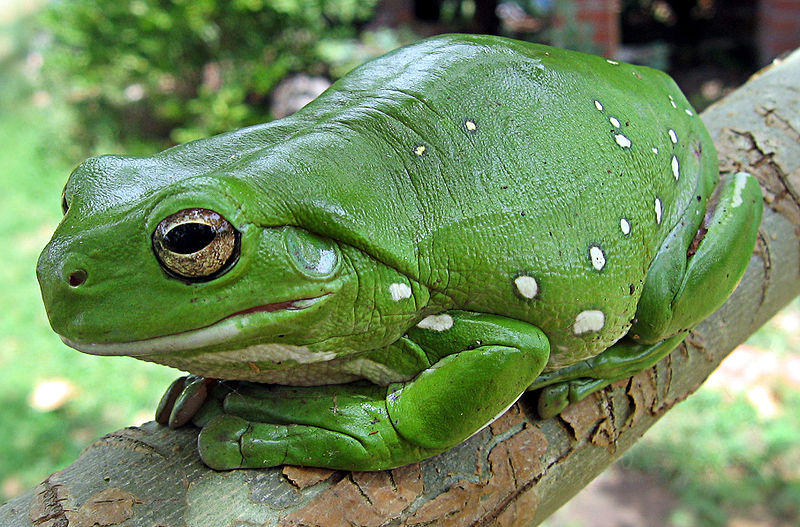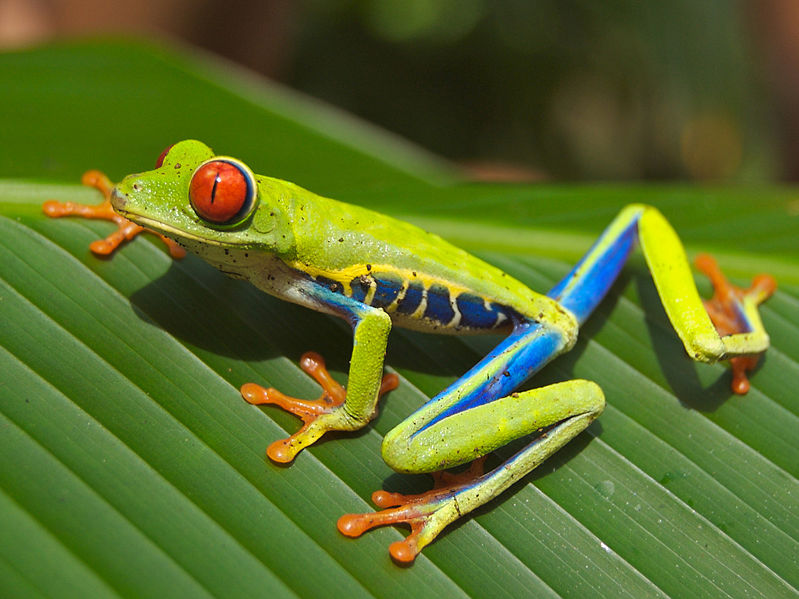 On the right is a Green Tree Frog. Green Tree Frogs inhabit northern Australia, and can reach 10cm or 4in long.
In captivity, the Green Tree Frog can live up to 16 years, a longer time than most other frogs!
Green Tree usualy sit in windows or houses to eat insects that are attracted to the light.
Green Tree Frogs are very docile.
They are nocturnal and come out in early evenings to call (in spring and summer) and hunt at night.
During the day they find cool, dark, and moist areas to sleep.
During winter, Green Tree Frogs do not call and are not usually seen.
Depending on their location, Green Tree Frogs occupy various habitats.
Typically, they are found in the canopy of trees near a still-water source.
However, they can survive in swamps (among the reeds) or in grasslands in cooler climates.
Green Tree Frogs are well known for inhabiting water sources inside houses, such as sinks or toilets.
They can also be found on windows eating insects.
They will occupy tanks (cisterns), downpipes (downspouts), and gutters,
as these have a high humidity and are usually cooler than the external environment.
The frogs are drawn to downpipes and tanks during mating season, as the fixtures amplify their call.
The species' call is a low, slow Brawk-Brawk-Brawk, repeated many times.
For most of the year, they call from high positions, such as trees and gutters.
During mating season the frogs descend, although remaining slightly elevated,
and call close to still-water sources, whether temporary or permanent.
Like many frogs, Green Tree Frogs call not only to attract a mate.
They have been observed calling to advertise their location outside the mating season, usually after rain,
for reasons that are uncertain to researchers.
They will emit a stress call whenever they are in danger,
such as when predators are close or when a person steps on a log in which a frog resides.
On the right is a Green Tree Frog. Green Tree Frogs inhabit northern Australia, and can reach 10cm or 4in long.
In captivity, the Green Tree Frog can live up to 16 years, a longer time than most other frogs!
Green Tree usualy sit in windows or houses to eat insects that are attracted to the light.
Green Tree Frogs are very docile.
They are nocturnal and come out in early evenings to call (in spring and summer) and hunt at night.
During the day they find cool, dark, and moist areas to sleep.
During winter, Green Tree Frogs do not call and are not usually seen.
Depending on their location, Green Tree Frogs occupy various habitats.
Typically, they are found in the canopy of trees near a still-water source.
However, they can survive in swamps (among the reeds) or in grasslands in cooler climates.
Green Tree Frogs are well known for inhabiting water sources inside houses, such as sinks or toilets.
They can also be found on windows eating insects.
They will occupy tanks (cisterns), downpipes (downspouts), and gutters,
as these have a high humidity and are usually cooler than the external environment.
The frogs are drawn to downpipes and tanks during mating season, as the fixtures amplify their call.
The species' call is a low, slow Brawk-Brawk-Brawk, repeated many times.
For most of the year, they call from high positions, such as trees and gutters.
During mating season the frogs descend, although remaining slightly elevated,
and call close to still-water sources, whether temporary or permanent.
Like many frogs, Green Tree Frogs call not only to attract a mate.
They have been observed calling to advertise their location outside the mating season, usually after rain,
for reasons that are uncertain to researchers.
They will emit a stress call whenever they are in danger,
such as when predators are close or when a person steps on a log in which a frog resides.
 The image on the left is of a Red Eyed Tree Frog.
Red Eyed Tree Frogs, as their name states,
have bold red eyes with vertically narrowed noses,
a vibrant green body with yellow and blue striped sides,
and orange toes.
Males range from 2 to 2 1/2 inches,
while female range from 2 1/2 to 3 inches on average.
Young frogs are typically brown in color and turn greener as they mature,
although adult frogs can change their color slightly depending on mood and environment.
Red Eyed Tree Frogs are not poisonous and rely on camouflage to protect themselves.
During the day, they remain motionless, cover their blue sides with their back legs,
tuck their bright feet under their belly,
and shut their red eyes.
Thus, they appear almost completely green, and well hidden among the foliage.
Red Eyed Tree Frogs are carnivorous and eat crickets, moths, flies, and other insects,
and have been known to eat other small frogs.
For froglets, fruit flies and pinhead crickets are the meals of choice.
The image on the left is of a Red Eyed Tree Frog.
Red Eyed Tree Frogs, as their name states,
have bold red eyes with vertically narrowed noses,
a vibrant green body with yellow and blue striped sides,
and orange toes.
Males range from 2 to 2 1/2 inches,
while female range from 2 1/2 to 3 inches on average.
Young frogs are typically brown in color and turn greener as they mature,
although adult frogs can change their color slightly depending on mood and environment.
Red Eyed Tree Frogs are not poisonous and rely on camouflage to protect themselves.
During the day, they remain motionless, cover their blue sides with their back legs,
tuck their bright feet under their belly,
and shut their red eyes.
Thus, they appear almost completely green, and well hidden among the foliage.
Red Eyed Tree Frogs are carnivorous and eat crickets, moths, flies, and other insects,
and have been known to eat other small frogs.
For froglets, fruit flies and pinhead crickets are the meals of choice.
